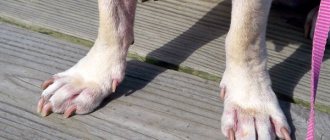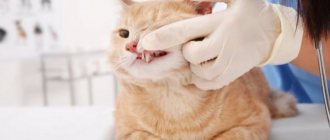Cat ears require special care and attention from humans. Hygiene, cleanliness and disease prevention are essential. Dirt and parasites cause the development of a number of ear diseases in cats, including dangerous ones.
The owner should regularly examine the pet so as not to miss the first signs of a problem. The article discusses the causes of such problems as hot cat ears, lichen, scabies mites and others. It tells you how to follow veterinarians' recommendations for care and how to clean your cat's ears.
Structure of a cat's ear
A cat's ears resemble human ears in structure and include:
- external, consisting of a funnel-shaped shell covered with wool with guard hairs inside and the auditory canal;
- in the middle there is an eardrum and a bone cavity with three bones, important in the perception of noise;
- internal - the most complex section, in which the vestibular apparatus and sound receptors are located.
In animals, the auditory canal, unlike the short human one, is curved and forms an angle. Improper cleaning can lead to wax buildup and blockage of the passage.
Cats can hear sound vibrations in the range of 20–100,000 Hz. Muscles and cartilage are able to rotate the shell to pinpoint the source of sound vibrations during hunting.
Drawing - diagram of the structure of a cat's ear
Sulfur plug
If you don't take care of your cat's ears, the risk of wax impaction increases. This is especially true for purebred representatives. Sulfur plugs, in most cases, lead to the onset of an inflammatory process - otitis media. Due to the disease, hearing begins to suffer.
It is best to entrust the removal of large amounts of sulfur to a professional. The process will require manipulations in which there is a possibility of damaging soft tissues or touching the cat’s eardrum.
The damage can be so severe that the pet subsequently becomes deaf.
Why do animals scratch their ears?
Scratching your pet's ears is a common hygiene procedure to remove dirt and particles. It is normal to itch several times a day.
What should alert the owner:
- When an animal constantly itches, shakes (shakes) its head vigorously, trying to free itself from an invisible object, and presses its ear with its paw.
- Anxiety, aggressiveness, irritability of the pet.
- Growling, hissing, meowing, and other sounds when scratching.
- Sores, sores, scratches behind the ears (near) and inside.
Such actions can be caused by domestic or pathological reasons.
Household problems are determined by the owner, go away on their own and do not require the intervention of a doctor. These are, in particular:
- water that got in while swimming;
- foreign object;
- minor hematoma from injury;
- scratches the neck - most likely fleas;
- accumulation of earwax due to insufficient care.
There may be cases when the pet lies down. So before you sound the alarm and take your cat to the vet, it’s better to make sure that there really is a problem.
Pathological causes are dangerous to health. The animal needs medical attention if the cause of scratching is:
- abscess;
- allergic reactions;
- fleas;
- fungal infections;
- benign or malignant neoplasms;
- otitis media of various origins;
- ear mites;
- eczema or dermatitis, going bald;
- swollen ear.
What diseases do ticks cause?
Ear scabies, also known as carnivore otodectosis, is a parasitic disease in which a mite lives in or on the pinna of the ear and infects the eardrum or ear canal. The blood-sucking insect causes itching, causing the cat to shake its head and meow. The ear may become scabby and fester. Without intervention, the disease causes complications: otitis, meningitis - or lead to the death of the animal.
Notoedrosis is caused by the sarcopid mite Notoedres cati. The ears, nose, and area under the eyes are affected. The tick affects the nervous, cardiovascular, and reticuloendothelial systems. First, the disease spreads to the muzzle and head, and then moves on to the rest of the body. The animal feels severe itching, scratches its ears, the skin dries out and becomes rough, and bleeding cracks and crusts form.
Otitis is an inflammation of the middle ear. The cat scratches its ears until wounds appear and shakes its head. At the same time, serous fluid with pus is released. This disease is caused by (where does it come from):
- ticks - as a complication of otodecosis;
- bacteria - with a weakened immune system or allergies, the yeast fungus Malassezia develops in the ears;
- both reasons at once - in this case mixed type otitis occurs.
Why is it important to do this
The cat is considered one of the cleanest animals. As for cleaning your ears, in this situation you cannot do without human help. For the first weeks of life, the little kitten is completely under the care of its mother. The cat licks the baby, including the ears, removing dust and accumulation of various debris from the kitten’s fur and skin.
What to do when a kitten is separated from its mother and finds itself in a different environment, you ask? Now responsibility for the maintenance, care and feeding of the pet rests with its owner. You need to accustom your kitten to ear cleaning from an early age. So, in the future the animal will not experience fear and discomfort during this procedure.
Ear cleaning is a mandatory hygienic procedure, as a result of which wax, dust, various small debris and accumulated moisture are removed from the ears. Ear cleaning also helps rid your pet of parasites such as ear mites. Accumulation of wax, excess moisture in the ear canal, the presence of mites - all this can provoke the development of various ear diseases, in particular otitis media and tumors.
You need to clean your ears as they become dirty or as soon as the kitten begins to give certain “signals”: often shakes its head, scratches its ears on the corners of furniture and any other surfaces, rubs them with its paws, meowing protractedly. As soon as you notice the accumulation of wax, dust and debris, the presence of dark spots, crusts, scratches, wounds or pus on the inner surface of the ear, it’s time to start performing hygiene procedures.
How to determine when it’s time to clean your ears, what happens if you don’t?
Hygiene is one of the main components of caring for a pet. It is better to examine your pet every day: when playing or petting, you can carefully bend the ear and then look. The pet's health is fine if the sink is light pink, clean or with a small amount of sulfur, not dirty (no blackness).
Excess wax accumulates in the ear canal, attracting bacteria and parasites. The sulfur plug leads to irritation of the mucous membrane and begins to put pressure on the eardrum. This spoils hearing and disrupts vestibular functions: leads to impaired coordination of movements, nausea, and vomiting.
Accumulations of dirt can clog the glands, and the contents of the ears can be absorbed into the blood, leading to allergic otitis media. Without treatment, the inflammation spreads deeper and can lead to the death of the animal. With tick-borne otitis media, the parasite eats dead skin cells and causes itching. Scratched areas appear around the cat's ears, and dark spots of pus and sulfur appear inside.
If your pet shakes its head, itches or worries, and black plaque, redness, discharge or spots appear in the ears, this is a reason to contact a veterinarian at the veterinary clinic.
Photo - this is what an ear mite looks like
Ear examination
A thorough examination once a week helps to detect the disease in time and eliminate it at an early stage. In normal condition, the ears should be warm, clean and slightly oily to the touch.
If your cat walks outside on its own, it is advisable to inspect its ears daily. She can injure them in a fight with other four-legged animals or pick up a tick. It is possible that a foreign object has entered.
To inspect, simply bend back the ear and look inside. You can use a flashlight to make the most secluded corners visible.
When to clean your ears
Cleaning is divided into preventive and therapeutic.
For preventive purposes, cleaning is carried out every 2–4 weeks, depending on the breed, as well as the body of a particular animal. The large ears of Maine Coon, Savannah, Cornish Rex, Abyssinian, Oriental, Somali, Siamese cats, Devon Rex, elves, and Sphynx cats get dirty faster.
Sulfur is especially actively secreted in breeds without hair inside the hearing organ, since the hairs protect against pollution.
It is difficult to clean the ears of the Scottish Fold on your own, so it is recommended to clean them once every two weeks. A small amount of secretion protects your pet from disease, so there is no need to clean it more often.
Therapeutic cleaning of a Scottish or British cat is carried out before treatment against ticks, the use of antibiotics or antifungal drugs. Before each use of drops or rinses, the sink should be cleaned with saline solution or lotion. Parasites and bacteria produce their own byproducts that interfere with the action of medications. Cleaning is prescribed by a veterinarian and is carried out until complete recovery.
Healthy clean ears of a British cat
Who suffers from ear problems most often?
Ear mites are transmitted from other animals through close contact. Most often, it affects cats that are often outdoors, living in nurseries or shelters. When bringing a new pet into your home, it should be quarantined for a while. This can protect other cats not only from tick infection, but also from other serious diseases.
Otitis media occurs when hygiene standards are not followed, when the pet is kept in a cool room or in a draft.
When bathing your pet, you need to protect its ears from water getting into them. After water procedures, you should immediately clean your cats ears with a dry soft cloth.
Kittens, old cats, or weakened animals suffer the most. In addition, some breeds of cats that have large ears or lack fur are susceptible to ear diseases. These are the Sphynx, Devon Rex, Maine Coon, Somali, Abyssinian and Oriental cats.
Symptoms of diseases
It is worth paying attention to the health of your pet if:
- redness of the skin;
- increased temperature in certain parts of the body;
- narrowing of the auditory canal;
- tumors;
- change in the color of sulfur;
- unpleasant strong odors;
- squelching sound when pressing;
- excessive sulfur secretion;
- accumulations of pus and fluid;
- various secretions with blood;
- decreased ability to perceive sounds;
- changes in behavior: the cat shakes its head or tilts it to one side, pulls its ear away or runs away when touched, often itches;
- black sulfur, streaks with impurities are a sign of a mite.
Black inclusions in sulfur are often ordinary dirt. If, after cleansing, minor inflammations remain on the skin, you should seek help from a specialist.
Colorless or milky discharge indicates a lack of microelements or vitamins.
Dry ears and waxy scales indicate dermatitis, as well as a lack of fat in the diet.
Allergies are indicated by colorless discharge from the nose, eyes, and ears.
The ears smell like fish if there is a staphylococcus infection, and rotten meat when there is suppuration.
Only a veterinarian can indicate the true cause of ill health and prescribe the correct treatment, so any of these symptoms require consultation.
Photo of bacterial otitis media
Tumor of the seruminous glands
How does the procedure work?
Since cleaning a cat’s ears at home is not at all difficult, owners can do it on their own. If the cat has been trained since childhood, hygiene measures can be easily carried out alone. For a stubborn animal, two people will most likely be needed.
Preparation
First you need to prepare all the tools and tools. Bottles and drops must be opened to act as quickly as possible.
Choose a place for the event - a quiet and bright room will do. If the procedure takes place in the dark, prepare a good lamp. Place it comfortably and steadily so that the light falls on the animal.
Next, gently secure your pet. This can be done by sitting him on your lap and squeezing him slightly towards you. If your pet breaks out and it becomes difficult to hold him, then available means will come to the rescue. You can swaddle your four-legged dog with a towel, protecting yourself from claws and teeth. Holding the animal's head with one hand, you can carry out the procedure with the other hand.
Another option is a retainer bag. It will free both hands of the owner and allow you to quickly carry out any hygiene procedure.
The third option is to enlist the help of household members. One person will hold and calm the cat while the other quickly examines and, if necessary, cleans the ears.
Algorithm of actions
After the mustachioed friend is immobilized and does not pose a threat to the owner, you can proceed to the main steps:
1.
Inspect the ear for discharge, scratches, or injuries. To do this, carefully turn it out. This is not dangerous and will not harm your mustachioed friend.
What you need to pay attention to:
- an unpleasant odor indicates suppuration or malignant formations;
- blood discharge: blood occurs with dermatitis and otodectosis, when the animal begins to scratch the affected areas vigorously, injuring the skin;
- tumor - looks like a hard nodule.
2.
Soak a napkin in the lotion and then squeeze it out so that excess moisture does not remain inside. Another option is to buy impregnated veterinary wipes.
3.
Gently rub a napkin or cotton pad over the contaminated areas. There is no need to penetrate deep into the ear canal, as this may subsequently cause the formation of wax plugs. The entire procedure must be performed within sight. Small stains can be removed with a cotton swab - but only from the outside.
4.
After the procedure, praise the animal and give it a treat. The pet should be left with a positive impression - he was not hurt, and then he was given a treat. Next time he will take the cleaning more calmly.
There is another option for cleaning your cat's ears at home. This method is appropriate when a lot of dust and dark secretions have accumulated:
- Take the drops and warm them to a comfortable (slightly above room) temperature. The solution should not be cold or hot.
- Drop the liquid into the ear canal and gently massage the base of the ear so that the medicine penetrates inside.
- Shake your pet's head to shake out excess solution. The bulk of the contamination will come out. If you need to remove residue, use a cotton swab. It is important not to make sharp circular movements so as not to injure the auditory organ.
Always be as gentle as possible with your pet, as such manipulations are stressful for them. Over time, when the cat gets used to it, everything will be perceived much easier for him.
How to clean a kitten's ears
How to clean a kitten's ears? Just like an adult cat, cleaning a baby’s ears is not difficult. But you need to act more delicately. Firstly, kittens have smaller ear canals, which means the cotton swabs will be too big. Secondly, you need to be careful when restraining a small pet.
Drops that are gently dripped into the ear canal and onto the inner surface are well suited for the procedure. After instillation, it is necessary to massage the shell for several minutes - for better penetration of the medicine. As with adult cats, it is best to massage at the base.
After this, release the kitten and let him shake his head so that the medicine along with the contamination comes out. Then wipe the kitten's head with a towel or cotton pad.
There is no need to thoroughly clean dirt from kittens - you risk causing damage. If the dirt has accumulated deeply, it is better to seek help from a veterinarian.
What not to do
There are a number of actions that absolutely cannot be performed:
- Under no circumstances should you wash your hearing organ with plain water. Always keep an eye on this when swimming - water should not get inside. It can provoke inflammation and suppuration, that is, otitis media.
- Chlorhexidine is not suitable for instillation. It should only be used for external cleaning.
- Do not use hydrogen peroxide, soap or alcohol-containing solutions. “Traditional medicine” can greatly harm your mustachioed friend: they dry out the skin, kill natural microflora and cause an allergic reaction.
- When restraining the animal, always make sure that it has something to breathe. The animal should be in a position that is comfortable for it.
Never forget the importance of the above-mentioned nuances. With some skill, you will learn how to check and clean your pet's ears quickly and without stress for both of you.
Preparing for cleaning: what to buy
To care for pets, only specialized preparations are used, especially when cleaning the ears. The products protect against fungus and bacteria, prevent infection, and are safe for pets. The instructions for the product should indicate cleaning, not instillation. Under no circumstances should you take anti-inflammatory drugs if there is no indication for it. For cleaning it is recommended to use:
- AUROCLEAN with chamomile extract softens sulfur;
- Leopard, Dewdrop for cleansing ears;
- EAR cleaner cleans;
- Euracon Pharma Otoklin removes dead skin cells, softens sulfur, moisturizes;
- Doctor Vic softens sulfur, used before using medications;
- Veda acts as an antiseptic, heals, removes inflammation;
- Vetoquinol Otifri eliminates impurities, relieves itching, and improves the condition of microflora.
Instead of lotion, you can use saline solution, boiled water, or chamomile decoction.
What is not allowed during processing is prohibited
The ears of adults and kittens are sensitive and need careful attention. Doctors do not recommend when cleaning:
- use soap, iodine, vinegar, alcohol lotions, hydrogen peroxide. These drugs can cause irritation and dryness;
- use cotton swabs, wrap cotton wool around matches. This can damage the eardrum or push debris into the ear canal instead of out.
Lumps or discharge in the ears are a signal to consult with veterinarians at veterinary clinics.
What is needed and the price for what is needed
A cotton pad is used to clean the ears. There is no need to use cotton swabs - they can cause serious damage. Gauze is also not suitable as it can damage soft tissue.
Before wiping the ear, the cotton pad must be moistened with lotion or other disinfectant. There are many options for cleaning.
Cat ear cleaning lotion
Cleaning lotion
The most affordable and popular product for this hygiene procedure. Another plus is the wide range of products. Most often, it is the lotion that pet owners choose as a means for treating their pet’s ears.
The price range is 150-700 rubles per package.
Ear hygiene drops
Drops
Ear hygiene drops are less common than lotion. In most cases, drops are a veterinary drug for the treatment of fungal and parasitic diseases. However, there are also disinfectants that leave no traces behind.
Ear drops contain substances that dissolve wax and other contaminants in the ears. As a rule, such products are used regularly, including after long walks or after bathing at home. The price for them is about 1200 rubles.
Cat ear powder
Powder
Powder is a means for regular treatment; its properties help eliminate itching and other unpleasant sensations in your pet. Bactericidal powder is very often used by owners of show animals.
The product is often recommended by veterinarians for treating ears during inflammatory processes. The average cost is 200-500 rubles.
The powder is also used to remove large amounts of hair on the inside of the ear. To do this, it is applied to the hairs and smoothly distributed with a cotton swab. After this, the hairs are pulled out, and the remains are carefully removed with a cotton swab. Antibacterial powder is more often used by dog owners than by cat owners. This product is one of the favorites among animal groomers.
Cat ear cleaning gel
Gel
There are so-called gels for cleaning the ear canals of cats. Their peculiarity is that they form a liquid upon contact with the skin, washing away all the dirt from the ears. After use, the gel does not leave any greasy stains.
To achieve greater effectiveness, apply the product to a cotton pad and wipe the pet’s ears with it. To clean the hearing aid, a small amount of gel is squeezed into it.
After this, the ear must be massaged. The pet itself will push all the dirt out; they are removed with a dry cotton pad.
Cleansing gels are rare and require significant expense. For 100 ml you will have to pay about 500-700 rubles.
Spray used to clean ears
Spray
Sprays are used not only for preventive purposes. Their use is prescribed by veterinarians if a pet is diagnosed with otitis media and other inflammatory processes in the ear.
The product contains substances that dissolve sulfur and other dirt. They also normalize the condition of the skin and have an anti-inflammatory effect.
The use of the spray is practically no different from other drugs. First, it is applied evenly throughout the ear, which is then gently massaged. The intensity of the massage depends on the general condition and pain. Then use a dry cotton pad to remove dirt from the inside of the ear.
Hygienic sprays rarely appear on the windows of pet stores and veterinary pharmacies. However, they are not expensive. Their average cost is 150-250 rubles per 100 ml.
Napkins
Wet germicidal wipes are very easy to use. They already have all the necessary substances for cleansing. It is enough to wrap your finger in them and carefully remove wax and other dirt. The wipes have antiseptic properties and gently cleanse the sensitive skin of the ear.
Wipes are available for the ears and eyes of cats. The availability and convenient use of this product makes it an ideal option for those who like to travel long distances with their pets. The price of napkins is completely different: for a package of 15-20 pieces you can pay 20-200 rubles. Packages with a large number of napkins are significantly more expensive: they are sold for both 200 and 700-800 rubles.
Battery operated ear cleaner
Special gadget Ear cleaner
Special ear cleaning devices are suitable not only for adults, but also for small kittens. The device is equipped with a backlight and a silicone nozzle that reliably removes all accumulations of sulfur.
The nozzle is specially made in the form of a spiral to reduce the likelihood of injury to zero. It also ensures the safety of the procedure even for small pets: kittens, puppies and rabbits. After use, the nozzle is thoroughly rinsed under warm water.
The device is gradually gaining popularity. It is not sold in all pet stores. On average it costs about 150-1000 rubles. As a rule, the kit already includes one battery.
Cleaning the ears of adult cats
Before the procedure, your pet should be calmed down. Screenings will not cause concern if done from a young age. To prevent the animal from harming itself and its owner when cleaning, the cat can be restrained by wrapping it in a soft towel, leaving its head outside.
Cleaning (washing) the ears of animals is not painful, but it is unpleasant. Wiping the inside of the ears of cats and dogs is not enough. Contaminants should be removed from the ear canal without damaging the organ. How to clean it properly:
- Place your pet on your lap or other comfortable surface.
- Apply the cleansing agent until the canal is filled.
- Press the edge of your ear to the ear canal and massage in a circular motion. The liquid inside should be audible.
- Make the cat shake its head. This will remove contaminants out.
- Wrap your finger in a paper towel (can be replaced with a napkin or gauze), remove any remaining dirt. There is still dirt left, repeat steps 2-4, move to the other ear.
- At the end of the procedure, give your pet a treat.
If there is too much contamination, a home procedure may not be enough. If an unpleasant odor appears, contact a specialist who will use professional cleaning products and also prescribe the necessary treatment, if necessary.
How to clean and rinse cat ears: tools and liquids
The cat's ears are cleaned of accumulated dirt and earwax using a swab, disk or cotton swabs . A soft cleaning surface is moistened with mineral oil and Vaseline.
These products help remove dried lumps without pain. Instead of Vaseline, you can use a little baby cream, a drop of peach or almond oil (purified, cosmetic).
Please note: liquid or fat should not drip from the cotton wool - there is no need for excessive wetting.
Rinse the ear with distilled water and saline solution in cases where it is necessary to clean the ear of blood and foreign substances. At home, they use an Esmarch mug, a large 20 ml syringe without a needle, and large bottles with a spout. The stream of water should not enter the ear canal, so the animal’s head is tilted slightly.
It is not recommended to use a match with a piece of cotton wool wound:
- Stiff - any wrong movement can cause pain.
- Short – it’s inconvenient to work.
After cleaning with a greasy product, wipe the ears with a dry cotton swab, absorbing any remaining cleaning product. If radical measures were taken—deep rinsing—the final step is to carefully blot the surface with a water-absorbing napkin or soft towel.
How to clean a kitten's ears
Kittens' ears require inspection and cleaning no less than those of adults. At the same time, the kitten behaves unpredictably and experiences stress.
How to care? The baby must be restrained before the procedure to avoid injury (usually, the kitten is not allowed to have its ears cleaned). An active kitten can be swaddled so that only the head is exposed. Do not tighten your pet's paws to avoid further scaring. After the procedure, give the kitten a treat to compensate for the stress caused. If you clean your kitten regularly, it will get used to it and become calmer. To clean, you will need cotton pads and cleansing lotion or boiled water.
- Gently open the ear with your thumb and forefinger.
- Wet the disc with cleaning fluid.
- Wipe the ear from the inside to the exit.
Need for cleaning
Should cats' ears be cleaned and why? The hearing aid has a very complex structure, hence there are so many practical questions.
Like other mammals, cats have glands that produce a special secretion - sulfur. This is a natural process necessary to protect the middle ear from dust, foreign particles and harmful microorganisms. Sulfur is released naturally during chewing of food, and the animal itself removes its excess while washing.
The process does not always go smoothly, and some individuals require the help of the owner.
Hygiene
Often the secretion that is not released accumulates, forming sulfur plugs, leading to hearing impairment. By putting pressure on the eardrum, the plug provokes unpleasant sensations in the form of pain, nausea, and dizziness.
It should be remembered that the auditory canal, in addition to the perception of sound, performs another function - it is responsible for the position of the body in space and the ability to maintain balance. In other words, it is closely connected with the vestibular apparatus, so if cleaning is not carried out on time, it can lead to deterioration of coordination.
Hygienic cleaning is performed if necessary - if the owner of the animal notices accumulations of wax in the ear. The ear needs to be examined weekly: if there is a dark or yellowish coating, it is carefully removed without going deep.
Prevention and treatment of diseases
The first examinations must begin at an early age, trying to accustom the kitten to the procedure, since it must be performed constantly. If you do not regularly inspect and clean, parasites may appear in the ear canal - wax is a good breeding ground for ear mites.
The increased attention of the four-legged animal to its “locators” can be considered an alarm bell. The animal begins to constantly itch, trying to get something out of the ear canal, or shake its head. If you observe such symptoms, take your mustachioed friend to the veterinarian immediately.
When treating ear diseases, you need to clean them 1-2 times a day with special products. The veterinarian will prescribe a regimen of procedures in accordance with the identified pathology.
Frequency of procedure
The amount of sulfur produced is influenced by many factors: breed, diet, activity, environment. Since the cat's “locator” is very sensitive to touch, too frequent intervention can cause unpleasant associations. Therefore, owners are worried about how often to clean their cat’s ears so as not to cause harm and not miss the onset of the disease?
There is no consensus among veterinarians. A lot depends on the breed of the pet - for example, hairless cats do not have hairs in their shells, so they produce an excess amount of sulfur for better protection.
Fold-eared breeds also need close attention - their ear canal is covered, and therefore ventilation is difficult. Also, increased secretion of sulfur is observed in older animals, individuals with chronic diseases, and in cats who have suffered from ear mites.
Accordingly, for such pets, inspection is carried out every two to three days, and cleaning is done every three to four days. For other breeds, an inspection once a week is sufficient. Do not confuse examination and cleaning - it is quite possible that your pet will only need intervention once every 3-4 months.










